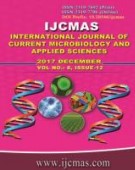


 National Academy of Agricultural Sciences (NAAS)
National Academy of Agricultural Sciences (NAAS)

|
PRINT ISSN : 2319-7692
Online ISSN : 2319-7706 Issues : 12 per year Publisher : Excellent Publishers Email : editorijcmas@gmail.com / submit@ijcmas.com Editor-in-chief: Dr.M.Prakash Index Copernicus ICV 2018: 95.39 NAAS RATING 2020: 5.38 |
Lack of hybrids/composites showing tolerant genes for moisture stress is responsible for low maize productivity in Kashmir. Present study was an attempt in this direction to assess the genetic variability of 100 homozygous maize inbred lines at different stages of selfing during kharif 2013 and 2014 at AICRP (Maize)-Srinagar Centre. Inbred lines were evaluated for obtaining information on genetic variability, heritability and genetic advance for maturity, morphological, physiological, yield and quality traits. A wide range of variability revealing significant response of main effects (lines, irrigations and years and their respective digenic and trigenic interactions) was observed. Upper range values suggest presence of elite lines exhibiting taller plants associated with more number of ears plant-1, more ear height, more number of kernels row-1, heavier grains, high yielders, better quality, high leaf relative water content, more chlorophyll content, earliness towards tasseling, silking, anthesis-silking interval, maturity and low canopy temperatures associated with low stomatal count. Medium to high values of genetic coefficient of variability accompanied with high heritability and high genetic gain (as % of mean) were exhibited for anthesis-silking interval, leaf relative water content, stomatal count, chlorophyll content before flowering, chlorophyll content before maturity, ears plant-1, grain yield plot-1, protein content all confirming that these traits can be given more weightage while applying selection for improvement of these traits and in identifying elite drought tolerant lines.
 |
 |
 |
 |
 |